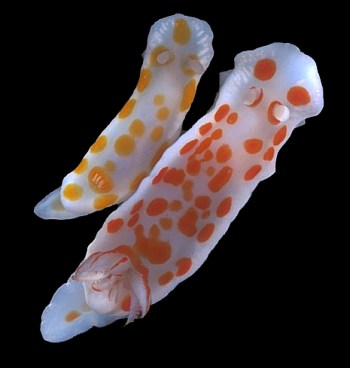
Chromodoris tasmaniensis
Bergh, 1905
Order: NUDIBRANCHIA
Suborder: DORIDINA
Superfamily: EUDORIDOIDEA
Family: Chromodorididae
DISTRIBUTION
SE Australia from New South Wales, Victoria, Tasmania, South Australia.
PHOTO
UPPER RIGHT: New South Wales colour form - Jibbon Head, Port Hacking, NSW, 20m, October, 1981, 21, 28mm long alive. Note the mantle glands showing as opaque white streaks around the anterior end of the mantle. LOWER LEFT: Southern colour form - Blackman's Beach, Hobart, southern Tasmania, February 1984, 24, 41mm long alive. On food sponge Darwinella gardneri. LOWER RIGHT:Goat Island Beach, Ulverstone, northern Tasmania, February 1984, 22, 34mm long alive. On food sponge Darwinella gardneri.
PHOTOS: Bill Rudman.
This is one of the many species of chromodorid in southeastern Australia with a colour pattern of red spots. Chromodoris tasmaniensis is characterised by a white body and mantle, with scattered red or orange spots. The rhinophore clubs are translucent white and the gills are translucent white with red or orange edgeing. Throughout its range the colour of the spots varies from red to light orange in different specimens. In New South Wales specimens the spots are large and while there can be a row of spots around the mantle edge they are part of an irregular scattering of spots all over the mantle. By comparison, specimens from Tasmania (and also Victoria and South Australia) have a distinct row of spots around the edge of the mantle. There are either few spots in the centre of the mantle, or many, but in all cases the outer band of spots is clearly defined.
Throughout its range C. tasmaniensis is usually associated with the reddish-pink food sponges Darwinella gardneri and Darwinella cf. australiensis. In New South Wales the chromodorid most similar in size, shape and colour to C. tasmaniensis is C. splendida, which also feeds on Darwinella cf. australiensis and is endemic to New South Wales. In southern Australia the most similar chromodorid is C. epicuria which also feeds on Darwinella gardneri and is endemic to Tasmania, Victoria and South Australia. Chromodoris splendida has large red spots (Rudman l983) scattered all over the mantle while C. epicuria has orange spots most of which are concentrated in a band around the mantle edge. Chromodoris tasmaniensis then has two colour forms, each within a discrete geographic range. Within each of the two ranges there is an endemic species of Chromodoris feeding on the same sponge which is extremely similar in colour and shape to the local colour form of C. tasmaniensis. I have discussed the possibility that these groups of similarly coloured species represent complex examples of mimicry (Rudman, 1991). See also the page on red spotted species.
References:
•Rudman, W.B. (1983 ) The Chromodorididae (Opisthobranchia: Mollusca) of the Indo-West Pacific: Chromodoris splendida, C. aspersa and Hypselodoris placida colour groups. Zoological Journal of the Linnean Society, 78: 105-173.
•Rudman, W.B. (1987a) The Chromodorididae (Opisthobranchia: Mollusca) of the Indo-West Pacific: Chromodoris epicuria, C. aureopurpurea, C. annulata, C. coi and Risbecia tryoni colour groups. Zoological Journal of the Linnean Society, 90: 305-407.
•Rudman, W.B. (1991) Purpose in Pattern: the evolution of colour in chromodorid nudibranchs. Journal of Molluscan Studies, 57, (T.E. Thompson Memorial Issue): 5-21.
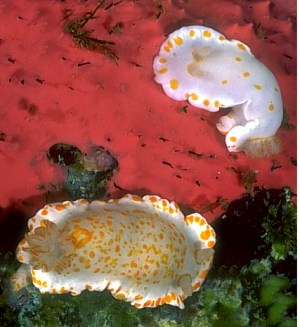
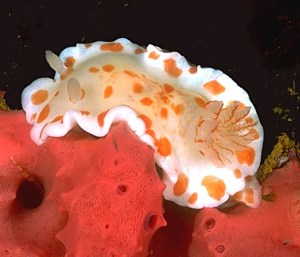
Rudman, W.B., 1999 (October 11) Chromodoris tasmaniensis Bergh, 1905. [In] Sea Slug Forum. Australian Museum, Sydney. Available from http://www.seaslugforum.net/find/chrotasm
Related messages
Chromodoris tasmaniensis from Bruny Island
January 8, 2007
From: Julie Marshall
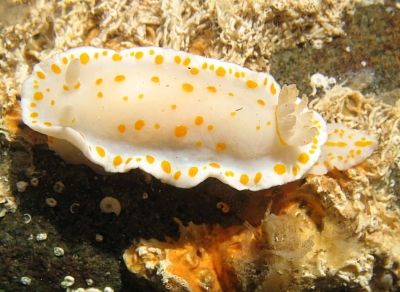
Dear Bill,
Attached is a photo of Chromodoris tasmaniensis from Adventure Bay, Bruny Island, Tasmania. It was found under a rock on its usual sponge though, as you can see, it had moved away from it by the time I took the photo.
Locality: Adventure Bay, Bruny Island, 1 m, Tasmania, Tasman Sea, 30 December 2006, Intertidal. Length: 35 mm. Photographer: Julie Marshall.
Best wishes,
Julie Marshall
juliemarshall@netspace.net.au
Marshall, J.G., 2007 (Jan 8) Chromodoris tasmaniensis from Bruny Island. [Message in] Sea Slug Forum. Australian Museum, Sydney. Available from http://www.seaslugforum.net/find/19167Thanks Julie,
This is an old favourite of mine - but from much cooler waters than your usual Heron Island contributions. It's interesting that C. tasmaniensis has both this pale yellow-orange colour form and the bright red colour form throughout its geographic range, althought the size and distribution of the spots change. In the southern part of its range - Victoria, Tasmania and South Australia, the spots are small and there is a distinct band around the mantle edge, while in the northern part of its range - New South Wales, the spots are large and randomly scattered. Have a look at the red-spotted chromodorid page for my ideas on this phenomenon.
Best wishes,
Bill Rudman
Chromodoris tasmaniensis from Botany Bay
June 9, 2005
From: Nicholas Missenden

Hello again,
Thank you for your help and information that you have given me so far. This site is a remarkable achievment and you are to be commended. I look forward to new posts everyday.
I have attached a picture of what appears to be a Chromodoris tasmaniensis as described here on your site. I just wanted to confirm that please as the colouration appears to be blotchy rather than spots. Did I just photograph a lazy nudi that couldnt be bothered forming spots. haha
Locality: Bare Island, South Wall, Boatnay Bay, NSW, Australia. Depth: 11 m. Length: 3 cm. April, 2005. Incoming tide, Photographer: Nicholas Missenden
Thanks again,
Nick
njmpm@iinet.net.au
Missenden, N.J., 2005 (Jun 9) Chromodoris tasmaniensis from Botany Bay. [Message in] Sea Slug Forum. Australian Museum, Sydney. Available from http://www.seaslugforum.net/find/13978Dear Nick,
Yes this is C. tasmaniensis, although your are right to be hesistant as there are quite anumber of these red-spotted chromodorids in south-eastern Australia. This one is sitting on its usual pink food sponge, Darwinella gardineri.
Best wishes,
Bill Rudman
Aggregation of Chromodoris tasmaniensis
March 25, 2005
From: Ron Greer
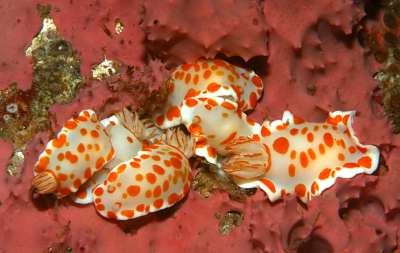
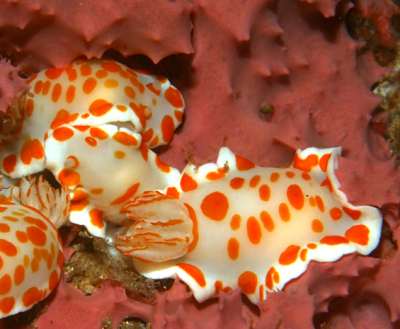
Bill,
Thought you may wish to add this aggregation of Chromodoris tasmaniensis to the Forum for no other reason than I don't think there is a similar image on the site. I found them in 3m under the Tathra Wharf, Tathra, Southern NSW in Nov 2004.
Locality: Tathra Wharf, New South Wales, Australia. Depth: 3 metres. Length: 50 mm. 21 Nov 2004. On sponge covered rock Photographer: Ron Greer
Regards,
Ron Greer
diveimage@netspace.net.au
Greer, R.I., 2005 (Mar 25) Aggregation of Chromodoris tasmaniensis. [Message in] Sea Slug Forum. Australian Museum, Sydney. Available from http://www.seaslugforum.net/find/13421Dear Ron,
Thanks Ron. Very glad to get this photo. This species tends to spend most, if not all, of its time on its food sponge, Darwinella gardineri, so a photo of a cluster of animals on their food is a quite typical sight for the species. These animals all show th typical New South Wales colour form of the species. The brighter white band around the mantle edge amrks the position of the ramifying mantle glands.
Best wishes,
Bill Rudman
Chromodoris tasmaniensis from Sydney
February 8, 2003
From: Allan Saben
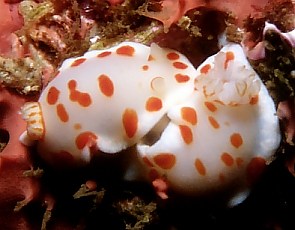
Hi Bill.
I took these two pics at Henry's Head, Botany Bay, Sydney [New South Wales, Australia] in about 22 meters of water. I was wondering whether you could please identify these two animals.
Many thanks,
Allan
asaben@optusnet.com.au
Saben, A., 2003 (Feb 8) Chromodoris tasmaniensis from Sydney. [Message in] Sea Slug Forum. Australian Museum, Sydney. Available from http://www.seaslugforum.net/find/8530Dear Allan,
These are a pair of Chromodoris tasmaniensis on their preferred food sponge.
Best wishes,
Bill Rudman
Chromodoris tasmaniensis from Sydney
December 9, 2002
From: Ian Simpson
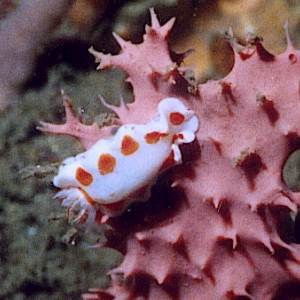
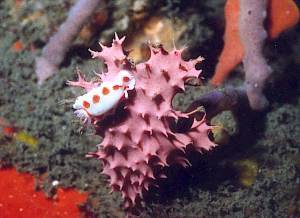
Dear Bill,
Here is a photo of Chromodoris tasmaniensis from Bare Island, [Botany Bay, Sydney, NSW, Australia] 8 September 2001. 15 metres.
Not a great photo of the specimen, but a good photo of its food sponge Dendrilla rosea. Although this would not provide you with any new information, you might want to include photos like this on the site that clearly show the food sponges so that novice nudi hunters like myself have a better idea where to poke around when searching for different species
Ian Simpson
barts computer@hotmail.com
Simpson, I., 2002 (Dec 9) Chromodoris tasmaniensis from Sydney. [Message in] Sea Slug Forum. Australian Museum, Sydney. Available from http://www.seaslugforum.net/find/8601Thanks Ian,
Yes I very much want to include photos like this of potential food sponges and any other biological observations. We have still a lot to learn about the natural history of most species so part of the aim of the Forum is to recruit all the eyes of interested amateurs so we can build up this information. Concerning the name of the sponge it feeds on. I ma afraid this group of sponges are not easy to identify and species can have a number of growth forms. The most recent advice I have is that this is a form of Darwinella gardneri.
Best wishes,
Bill Rudman
Chromodoris tasmaniensis I presume
October 24, 1999
From: Des Paroz

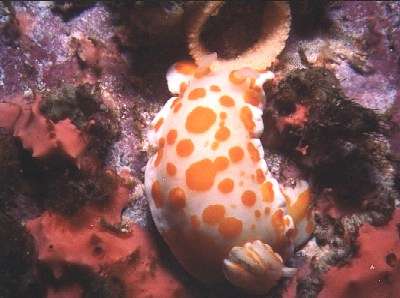
Hi Bill
The attached photos were taken on 17 October at Toothbrush Island, off Wollongong, southern New South Wales at a depth of about 14.5m.
I've seen this species regularly at this site, generally in the same basic area. Interestingly I've not seen this species at any other sites in the Illawarra region.
We'd had a dive at the same site the day before, and I found these species in a certain spot, the next day I took the camera back (I'd been wanting to get some shots of these for a while). The nudis were within inches of where they'd been 24 hours before.
I presume these are Chromodoris tasmaniensis?
Best regards
Des Paroz
http://www.divesite.paroz.com
des@paroz.com
Paroz, D., 1999 (Oct 24) Chromodoris tasmaniensis I presume. [Message in] Sea Slug Forum. Australian Museum, Sydney. Available from http://www.seaslugforum.net/find/1449Des,
Yes this is C. tasmaniensis. In your lower photo it is clearly associated with its food sponge Darwinella gardneri. This is one of the chromodorid species which are almost always found with their particular food sponge(s). I am not sure if all the species which are found with their food are direct developers, but this species is. Most nudibranchs lay eggs which develop into larvae which hatch from an egg mass as free-swimming veliger larvae. In those species with direct development, the egg develops into a tiny crawling slug which hatches from the egg and immediately begins life as a crawling slug. In such species it is a distinct advantage for the adults to lay their eggs on their food sponge so that their hatching young have immediate access to food.
I suspect that if there is sufficient food, individuals of C. tasmaniensis stay on the same colony of sponge, or patch of colonies, for their entire life.
Best wishes,
Bill Rudman.
Food of Chromodoris tasmaniensis
October 13, 1999
From: Bill Rudman
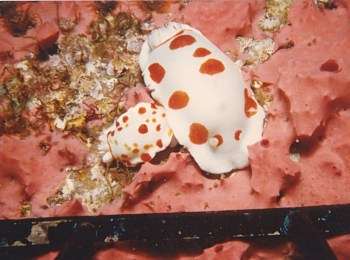
Tidying up some files today I found this photo of Chromodoris tasmaniensis on its normal New South Wales food supply, Darwinella cf. australiensis.
It was taken by Geoff Avern at North Bondi, Sydney, NSW, January 1981.
Bill Rudman.
Chromodoris tasmaniensis & C. epicuria in SE Australia
October 13, 1999
From: Bill Rudman
While preparing a photo by Geoff Avern of the relatively common southeastern Australian chromodorid Chromodoris tasmaniensis, I was somewhat embarrassed to realise I hadn't prepared a page on it. So here is one. It is one of the three common large red-spotted species in south-eastern Australia. It has two geographic colour forms, the one in New South Wales mimicking C. splendida, and the one further south in Victoria, Tasmania and South Australia mimicking C. epicuria, another species which I have just prepared a page for.
Best wishes,
Bill Rudman
